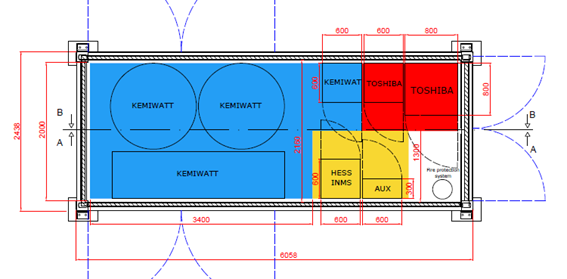As mentioned in priors’ articles, electrical grids worldwide are experiencing substantial structural and operational changes. Social, political, and economic factors push to a decrease of the fuel consumption and a limitation of undesirable emission while the global demand continues to increase.
The development of generation, storage and power electronic technologies gives rise to a wide variety of solutions to the current and future needs in the energy field at different levels.
A HESS (Hybrid Energy Storage System) permits to combine the features of the various technology to be integrated in a system all-in-a-box, leveraging their synergies, and extending their performances.
In this article, we are talking about the “box”, and the solution taking by Hybris to manage all the technologies.
Regarding ESS technologies, there is a high variety with different features:
- UCAPS:
- high power density response (from msec to few minutes)
- quick response
- Very high reliability (> 1.000.000 cycles). Without any chemistry.
- Power batteries – Li-Ion LTO, High Power NMC:
- Power density – energy density response (from 5 minutes to 15 minutes)
- Energy batteries – Li-Ion NMC or LFP:
- High energy density response (from 15 minutes to 1 hours).
- Very High Energy: Lead Crystal®, Aqueous Batteries, Fuel Cells, NaS, Flow Batteries, etc.
- Very high energy density response (from 4 hours to 12 hours)
Hybris Project uses two different technologies, li-ion batteries (power), and red flow batteries (energy). To manage these technologies, the system integrates an Advance Battery Management System (ABMS), an Energy Management System (EMS), a Power Management System (PMS), a Scada and a HIL.
Hesstec provides the PMS, Scada, and the communication API to the consortium. The PMS is our Intelligent Node Management System (InMS™), a hardware and software control platform integrating proprietary algorithms, oriented towards an optimal planning and multi-service operation by the end-user based on a deep know-how of the storage technologies and their performance into real grid scale applications.
This is the Power Management System (PMS) or Power Plant Controller of HESStec, that can be configured different applications, from off-grid microgrids to grid-connected applications with external communications with the SCADA of DSO/TSO or connection to energy market platforms.

While ABMS and EMS works in the cloud, HESStec integrates the Batteries, BMS, HIL and PMS into a single and seamless containerized solution. Hybris container is a 20 feet HC container. The containerized solution allows transporting the system to different locations to test the versatility of the system.

The picture below shows the distribution of the parts of the system inside the container.

Containerized solution includes all the necessary systems to run the container under safety such as fire protection, ventilation, air conditioning, electrical protection, the additional protection, and switchgear for a safe operation and all the necessary systems to start up and operate the container.
Hesstec will perform its validation at the HESStec site under real conditions. After this validation, the container will be transported to different sites to test it. These tests are fundamental for ensuring the success at pilot demonstrations, allowing a reduction of the testing period at the site, and minimizing possible failures.
Tests will be performed according to the power of the container, emulating real grid conditions for the validation of the integrated HESS. In this sense, a protocol will be developed to validate the integrated HESS and their main functionalities prior to its shipment to the pilot demonstrations.
The SCADA will include the monitoring of every significant electrical node for additional monitoring of voltage, current and power for safety and characterization. This SCADA will communicate with both EMS and PMS. The HIL to create these conditions will be set-up into HESStec site from both electrical and ICT point of view, ensuring the creation of emulated real grid conditions in HESStec’s site. The HIL will be also integrated under the SCADA for a safe and proper operation of the overall setup.
Written by Carlos Blasco from HESStec